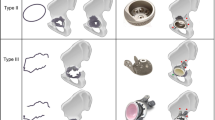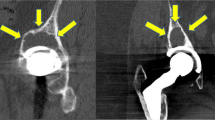Abstract
Purpose
Although isolated revision of the acetabular component has become an increasingly common option for revision hip surgery, opinions differ regarding the ideal surgical approach for reducing postoperative instability. The purpose of this study was to compare the clinical and radiographic results of isolated acetabular revision performed using a posterolateral and an anterolateral approach.
Materials and methods
The authors retrospectively compared the clinical and radiographic results of isolated acetabular revision performed in 33 hips using a posterolateral approach with those performed in 36 hips using an anterolateral approach. All procedures were performed by a single surgeon and all patients received the same postoperative protocol. Mean duration of follow-up was 4.6 years (range 2–13.2).
Results
Mean postoperative Harris hip scores were similar in the posterolateral and anterolateral groups (86.5 and 87.2 points, respectively). In the entire series of 69 hips, 6 (9%) underwent re-revision of the acetabular component because of aseptic cup loosening in 4, recurrent dislocation in 1, and deep infection in 1. No significant difference was found between the two groups with respect to complication or re-revision rates, but the dislocation rate in the anterolateral approach group was significantly lower than that in the posterolateral group (0 vs. 12%, p = 0.047).
Conclusion
Isolated acetabular revision performed using an anterolateral approach seems to be the more viable option in selected patients, and in particular, it has a significantly lower postoperative dislocation rate than posterolateral acetabular revision.
Similar content being viewed by others
References
Berry DJ, Harmsen WS, Cabanela ME, Morrey BF (2002) Twenty-five-year survivorship of two thousand consecutive primary Charnley total hip replacements: factors affecting survivorship of acetabular and femoral components. J Bone Joint Surg Am 84-A:171–177
Blom AW, Astle L, Loveridge J, Learmonth ID (2005) Revision of an acetabular liner has a high risk of dislocation. J Bone Joint Surg Br 87:1636–1638
Boucher HR, Lynch C, Young AM, Engh CA Jr, Engh C Sr (2003) Dislocation after polyethylene liner exchange in total hip arthroplasty. J Arthroplasty 18:654–657
Bozic KJ, Kurtz SM, Lau E, Ong K, Vail TP, Berry DJ (2009) The epidemiology of revision total hip arthroplasty in the United States. J Bone Joint Surg Am 91:128–133
Chen XD, Waddell JP, Morton J, Schemitsch EH (2005) Isolated acetabular revision after total hip arthroplasty: results at 5–9 years of follow-up. Int Orthop 29:277–280
D’Antonio JA (1992) Periprosthetic bone loss of the acetabulum. Classification and management. Orthop Clin North Am 23:279–290
DeLee JG, Charnley J (1976) Radiological demarcation of cemented sockets in total hip replacement. Clin Orthop Relat Res 20–32
Harris WH (1969) Traumatic arthritis of the hip after dislocation and acetabular fractures: treatment by mold arthroplasty. An end-result study using a new method of result evaluation. J Bone Joint Surg Am 51:737–755
Harris WH (1980) Advances in surgical technique for total hip replacement: without and with osteotomy of the greater trochanter. Clin Orthop Relat Res 188–204
Jamali AA, Dungy DS, Mark A, Schule S, Harris WH (2004) Isolated acetabular revision with use of the Harris-Galante Cementless Component. Study with intermediate-term follow-up. J Bone Joint Surg Am 86-A:1690–1697
Jones CP, Lachiewicz PF (2004) Factors influencing the longer-term survival of uncemented acetabular components used in total hip revisions. J Bone Joint Surg Am 86-A:342–347
Kim YS, Kim YH, Hwang KT, Choi IY (2009) Isolated acetabular revision hip arthroplasty with the use of uncemented cup. J Arthroplasty 24:1236–1240
Lawless BM, Healy WL, Sharma S, Iorio R (2010) Outcomes of isolated acetabular revision. Clin Orthop Relat Res 468:472–479
Learmonth ID, Young C, Rorabeck C (2007) The operation of the century: total hip replacement. Lancet 370:1508–1519
Manning DW, Ponce BA, Chiang PP, Harris WH, Burke DW (2005) Isolated acetabular revision through the posterior approach: short-term results after revision of a recalled acetabular component. J Arthroplasty 20:723–729
Martell JM, Pierson RH 3rd, Jacobs JJ, Rosenberg AG, Maley M, Galante JO (1993) Primary total hip reconstruction with a titanium fiber-coated prosthesis inserted without cement. J Bone Joint Surg Am 75:554–571
Moskal JT, Danisa OA, Shaffrey CI (1997) Isolated revision acetabuloplasty using a porous-coated cementless acetabular component without removal of a well-fixed femoral component. A 3- to 9-year follow-up study. J Arthroplasty 12:719–727
O’Brien JJ, Burnett RS, McCalden RW, MacDonald SJ, Bourne RB, Rorabeck CH (2004) Isolated liner exchange in revision total hip arthroplasty: clinical results using the direct lateral surgical approach. J Arthroplasty 19:414–423
Paprosky WG, Perona PG, Lawrence JM (1994) Acetabular defect classification and surgical reconstruction in revision arthroplasty. A 6-year follow-up evaluation. J Arthroplasty 9:33–44
Smith TM, Berend KR, Lombardi AV Jr, Mallory TH, Russell JH (2005) Isolated liner exchange using the anterolateral approach is associated with a low risk of dislocation. Clin Orthop Relat Res 441:221–226
Soni RK (1997) An anterolateral approach to the hip joint. Acta Orthop Scand 68:490–494
Suh KT, Roh HL, Moon KP, Shin JK, Lee JS (2008) Posterior approach with posterior soft tissue repair in revision total hip arthroplasty. J Arthroplasty 23:1197–1203
Tompkins GS, Jacobs JJ, Kull LR, Rosenberg AG, Galante JO (1997) Primary total hip arthroplasty with a porous-coated acetabular component. Seven-to-ten-year results. J Bone Joint Surg Am 79:169–176
Wade FA, Rapuri VR, Parvizi J, Hozack WJ (2004) Isolated acetabular polyethylene exchange through the anterolateral approach. J Arthroplasty 19:498–500
Conflict of interest
The authors declare that they have no conflict of interest.
Author information
Authors and Affiliations
Corresponding author
Rights and permissions
About this article
Cite this article
Park, YS., Moon, YW., Lim, BH. et al. A comparative study of the posterolateral and anterolateral approaches for isolated acetabular revision. Arch Orthop Trauma Surg 131, 1021–1026 (2011). https://doi.org/10.1007/s00402-011-1258-9
Received:
Published:
Issue Date:
DOI: https://doi.org/10.1007/s00402-011-1258-9




